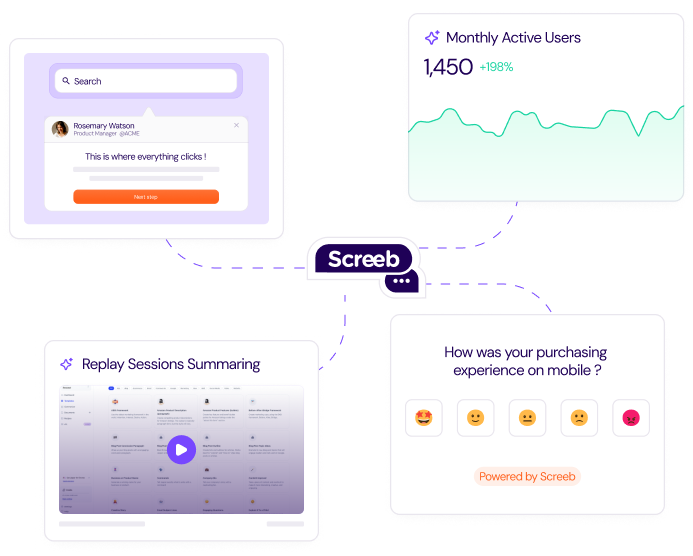Built for product teams who want to ship the right product.



Product
Teams Love Screeb


“Checking Screeb is now the first thing I do every morning. It helps us to spot frictions and improvement opportunities that we’ve never discovered before.”
“Screeb helps us to spot product improvements and to align our teams on the right priorities. It became a central tool for our Product Team to build the future of accounting software.”
“Faced with two competing options, we weren’t sure which one was more appropriate.Thanks to Screeb, we were able to quickly target and survey users about their preferred option, and confidently decide which version to develop.”
Why building products and experiences your users love is harder than ever
Your product team is expected to move fast and deliver results.
But with fragmented tools, low response rates, and shallow insights, you end up relying on gut feeling more than real data.
Session replays show what users do, but not why.
Surveys don’t get answers when you need them.
Interviews take time, and feedback gets lost in docs and Notion pages.
Analytics tell part of the story — not enough to prioritize with confidence.
You’re stuck trying to understand users with tools that weren’t built for product teams.

Solve that with Screeb
Collect & centralize thousands of Quantitative & Qualitative User Feedback in no time at scale
Easily collect and centralize thousands of User Feedbacks in no time with our high engaging in-App Customer Feedback Platform.
- Targeted surveys and audiences
- Audio & video in-App Survey for Web & Mobile
- 60% Response rate of in-App Surveys on average
- Library of survey templates
- 4,7/5 Ease-of-Use on Capterra
.png)
+40%
Read Case Study

Understand and Meet User Expectations with our AI Customer Feedback Analysis tool
Our platform goes beyond basic User feedback analysis to intelligently highlights actionable insights, turning complex and massive volume of feedback into clear and strategic Product directives.
- UX Funnel Report & Real-time Analysis
- Product & UX metrics: CES, NPS, CSAT
- Automatic AI Transcription & Analysis for Video & audio
- AI-powered User Feedback Reports
- Integrated with your Product Stack: Amplitude, Segment, Jira Product Discovery...
.png)
Only one Platform to prioritize, launch, communicate and implement Product features based on User Insights
Our platform provide features to ask your users, visualize their journey, guide them through your product and engage with them along the way.
- Smart surveys and targeting
- Session replays
- Product tours and messages
- AI reports and dashboards
- Release management

+40%

- GDPR Compliant: our data are hosted in France
- All Your User Insights, Feedback, Engagement, and Onboarding — in One Platform
- Strong performances on response rate
- Ease of technical deployment
- Ease of use & smooth UX
- Integrated with the rest of your stack: Amplitude, Segment, Notion, Slack, Jira, Contentsquare...
- A team dedicated to your success: technical support available via livechat, customer success manager, month reviews...

Head of Product @ Epsor

Your team has limited ressources?
Don't worry, you can do more with less.
That's 120 days per year saved on your budget! Estimate the impact for your own organisation
Limited Budget?
Estimate how much you could save by implementing a Customer Feedback tool
Not sure?
We compiled all testimonials to explain why our customers love Screeb
Why Screeb?
We created a complete benchmark with Pros & Cons of Screeb and our competitors
Frequently Asked Questions
You may still have questions. This is our responses:






